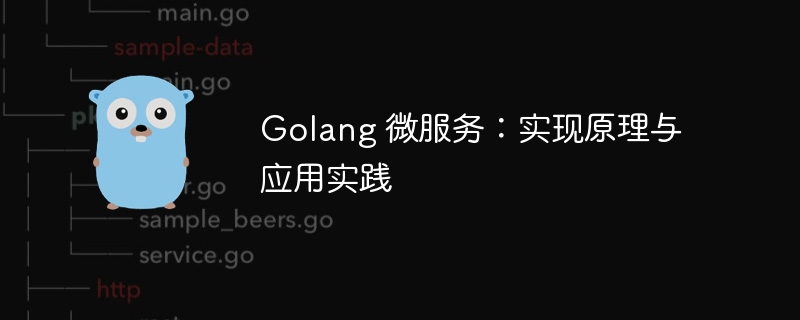

"Golang Microservices: Implementation Principles and Application Practices"
With the development of cloud computing and containerization technology, microservice architecture is increasingly widely used in various software systems. As an efficient and lightweight programming language, Go language (Golang) also performs well in microservice development. This article will explore the implementation principles of Golang microservices and combine them with specific code examples for application practice.
Microservice architecture is an architectural pattern that splits a software system into multiple small services that are independent and can be deployed independently. Each microservice focuses on completing specific business functions and achieves system flexibility, scalability and fault tolerance through lightweight communication mechanisms and independent deployment.
In a microservices architecture, communication between microservices usually occurs through HTTP, RPC, or message queues. Each microservice can use different programming languages and technology stacks to achieve optimal performance and efficiency.
Implementing microservices in Golang mainly relies on third-party libraries such as net/http packages and gorilla/mux provided in its standard library. The following are the basic steps to implement Golang microservices:
Next, we use a simple example to demonstrate how to use Golang to implement a simple microservice. Suppose we want to implement a user management service, including the user's addition, deletion, modification and query functions.
package main import ( "fmt" "net/http" "log" ) func main() { mux := http.NewServeMux() mux.HandleFunc("/users", handleUsers) server := &http.Server{ Addr: ":8080", Handler: mux, } log.Fatal(server.ListenAndServe()) } func handleUsers(w http.ResponseWriter, r *http.Request) { switch r.Method { case http.MethodGet: // 处理查询用户列表的逻辑 case http.MethodPost: // 处理创建用户的逻辑 case http.MethodPut: // 处理更新用户的逻辑 case http.MethodDelete: // 处理删除用户的逻辑 default: w.WriteHeader(http.StatusMethodNotAllowed) return } }
mux.HandleFunc("/users", handleUsers)
Implement the query in the handleUsers function User, create user, update user and delete user logic.
Through the above steps, we can implement a simple user management microservice. Of course, in actual development, we also need to consider the implementation of exception handling, logging, security verification, etc. to ensure the stability and security of microservices.
This article introduces the implementation principles and application practices of Golang microservices, hoping to help readers better understand how to use Golang to build an efficient microservice system. Although microservices architecture offers many advantages, it also requires careful design and implementation to realize its maximum benefits. I hope everyone will continue to explore in practice and create a more robust and reliable software system.
The above is the detailed content of Golang microservices: implementation principles and application practices. For more information, please follow other related articles on the PHP Chinese website!
 The difference between distributed and microservices
The difference between distributed and microservices How to define variables in golang
How to define variables in golang What are the data conversion methods in golang?
What are the data conversion methods in golang? What are the commonly used libraries in golang?
What are the commonly used libraries in golang? What is the difference between golang and python
What is the difference between golang and python How to get page elements using javascript
How to get page elements using javascript Solution to missing xlive.dll
Solution to missing xlive.dll NumberFormatException
NumberFormatException



